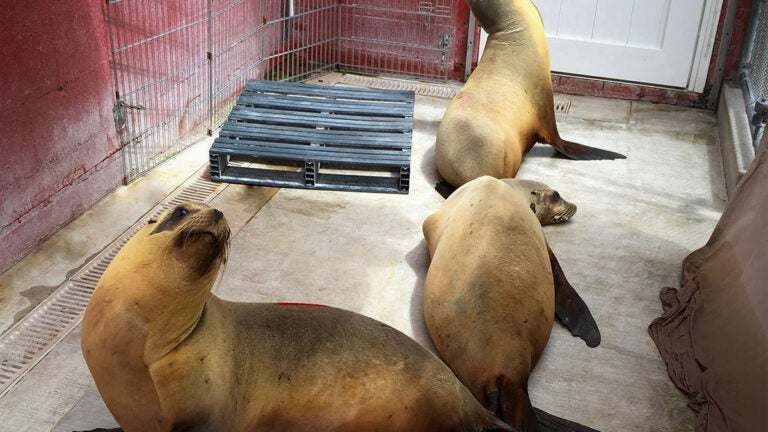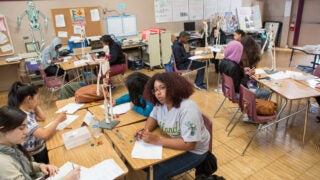
Sea lions rescued in the spring of 2017 were treated for domoic acid toxicity. (Photo/Courtesy of Pacific Marine Mammal Center)
USC 2018 | Groundbreaking research keeps Trojans on the cutting edge
? Year in review: One of the nation’s leading research universities, USC again was in the forefront of health, the environment and much more
The year in research at USC during 2018 showcases the diversity and depth of the university’s innovative endeavors befitting an elite institution.
Each year, hundreds of research papers gain notoriety in leading scientific journals and news outlets, helping propel knowledge beyond the lecture hall and lab and into society. Cutting-edge research in health, humanities and science and engineering make USC a magnet for research funds and top-notch faculty and students.
What sets USC apart is its interdisciplinary heft. Dozens of diverse schools and research centers at USC converge upon wicked problems with combined creativity to solve challenges such as climate change, disease, social injustice and technological transformation.
This year also marked the first full year of the USC Michelson Center for Convergent Bioscience and completion of the Norris Healthcare Center. The Michelson Center is home to 30 researchers dedicated to forging groundbreaking discoveries that cross traditional boundaries of medicine, engineering, biology and chemistry.
Consider that USC:
- Ranks 20th worldwide in the Thomson Reuters innovation ranking of world research universities.
- Spends $764 million for research annually.
- Ranks 10th among private research universities in federally funded research expenditures.
- Enrolls 12,000 students pursuing degrees in the health professions.
- Features the largest graduate program in science, engineering and health of all U.S. research universities.
The scale of the enterprise matches the aspiration of USC’s research vision. By transforming higher education through convergent research, USC is better positioned to transform society. Research endeavors this past year demonstrated the university’s commitment to making the world and local community better. Scientists searched and seized opportunities to remedy intractable problems to protect the planet, save lives, support underprivileged people seeking to improve their lot, reinvent medicine and improve caregiving, health and wellness for all.
https://research.usc.edu/usc-stats-and-rankings/
Here’s what that looks like in practice.
? Children’s health
Protecting children is one of the main purposes of society, and researchers at the Keck School of Medicine of USC advanced children’s health in many ways. For example, scientists discovered disconcerting links between excessive use of digital devices and behavioral problems in teens. And USC scientists identified complex and troubling links between asthma and obesity – two epidemics afflicting children.
https://news.usc.edu/146032/digital-media-use-linked-to-behavioral-problems-in-kids/
https://news.usc.edu/150074/asthma-and-obesity-link-seen-in-children-in-europe-study/
? With an optimistic eye
Healing and hope are the main goals of medical research, and USC is a fountainhead of research motivated by people striving to help others. To wit, researchers in the USC Dornsife College of Letters, Arts and Sciences identified a potential new targeted drug treatment for hearing loss, which afflicts about two-thirds of people more than 70 years old.
https://news.usc.edu/140224/
Researchers at the Herman Ostrow School of Dentistry of USC discovered an innovative way that might one day alleviate that unpleasant trip to the dentist. Searching for a way to fix cavities without drilling, scientists are testing a revolutionary gel that replicates tooth enamel.
https://news.usc.edu/140415/
Alzheimer’s is a disease that can bankrupt families financially and emotionally. It’s a wicked problem for which there is no cure even though it was discovered more than a century ago. At USC, nearly 100 researchers are focused on the disease. Among the discoveries, they have found telltale markers for early detection to diagnose the disease, an advance that can lead to better treatment and quality of life for patients. They are focused on weaknesses in the brain’s vascular system manifest before the accumulation of toxic plaques and tangles in the brain that bring about Alzheimer’s disease.
https://news.usc.edu/135765/half-of-all-dementias-start-with-damaged-gatekeeper-cells/
And America’s opioid crisis has claimed more than 300,000 lives since 2000, prompting USC researchers to action. Scientists are exploring ways to nudge physicians to better account for patients and prescriptions. Research at the Keck School of Medicine has shown that early intervention for opioid treatment is critical as use portends a fast-track to heroin use, which involves needles and increased risk of injection-related epidemics such as hepatitis C and HIV.
https://news.usc.edu/137121/opioid-abuse-leads-heroin-use-hepatitis-c-epidemic-usc-researcher-says/
? Environmental health
With a rapidly warming Earth and growing scarcity for resources and wildlife, USC scientists find themselves on the cutting edge of environmental science. It’s a natural fit for USC due to California’s extraordinary biodiversity and the university’s proximity to the Pacific Ocean and Los Angeles megalopolis. In a warning against relaxing auto vehicle pollution standards, researchers at the Sol Price School of Public Policy published research and commentary proving how the federal government manipulated data to justify rolling back regulations.
https://news.usc.edu/152375/rules-to-boost-fuel-economy-for-passenger-vehicles-will-do-more-good-than-harm-new-study-shows/
In a classic example of research convergence, USC researchers produced local maps pinpointing smog hotspots in L.A. County. Chinatown had some of the worst air quality; Altadena had some of the best. The project is a joint collaboration between USC Annenberg School for Communication and Journalism, USC Viterbi School of Engineering, USC Dornsife College of Letters, Arts and Sciences and the Keck School of Medicine.
https://news.usc.edu/144493/
Meanwhile offshore, marine scientists report a comprehensive, 15-year-long survey of ocean conditions showing Southern California has emerged as a global toxic algae hotspot. Their samples captured some of the highest levels of domoic acid – a toxicant for marine mammals and people – ever reported.
https://news.usc.edu/147515/southern-californias-coast-emerges-as-a-toxic-algae-hot-spot/
? Food, nutrition and more
Food is sustenance for the body and for research, and USC scientists working at the cutting edge of health, nutrition and physiology report extraordinary discoveries. For example, research from the USC Leonard Davis School of Gerontology shows that diets that mimic fasting can benefit health and improve longevity.
https://news.usc.edu/135551/
And on a sour note, scientists at USC Dornsife discovered that the protein enabling people to taste the pucker of a lemon are found in the ear and mouth. It’s the latest enigmatic discovery about how some of the body’s senses of smell and taste are governed in unexpected ways.
https://news.usc.edu/135537/surprising-discovery-links-sour-taste-to-the-inner-ears-ability-to-sense-balance/



